Croatia Ferry Guide 2022: From Šibenik to Obonjan, Vodice, Žirje, and More
June 28, 2022 - In the newest TCN series, we take a look at the destinations you can visit by ferry from the main Croatian ports. In this fourth installment of our Croatia Ferry Guide 2022, where to go from the port of Šibenik?
When advertising the Adriatic Sea and the Croatian islands abroad, the experience of being on board a sailboat, yacht, or catamaran is usually highlighted. However, there is no destination a Croatian ferry can't reach, and why not mention that it's totally worth saving a good amount of euros on sailboat rentals and crews?
Today we tell you more about the island destinations you can reach from the ferry port of Šibenik.
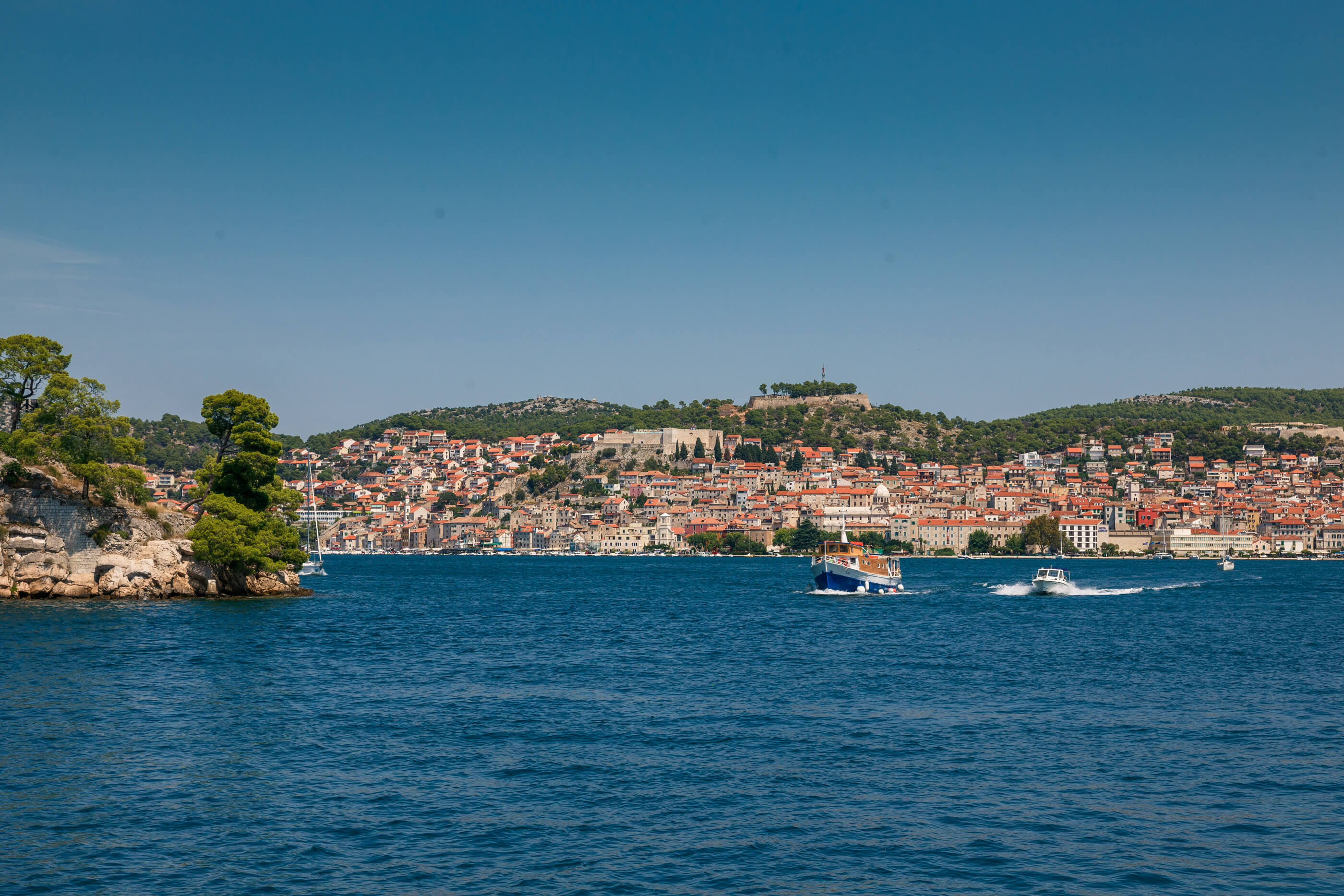
Photo: Mario Romulić
First of all, how to buy your ferry tickets? There are three ways. The first is via the official Jadrolinija website. In it, you can not only see the updated sailing schedules, but you can also buy your tickets online. Simply choose the port of departure, the port of destination, and the date of your trip, and you will find the available times. Once you have chosen the time and the number of tickets, in addition to completing all your personal information, you can proceed to pay for your tickets online with a credit or debit card.
The second way is through the official Jadrolinija mobile app, available on the Apple App Store and Google Playstore for Android. The application is very easy to use and, just like on the website, just select the port of departure and you will be able to see the ports that you can travel to from the one you selected. The process is very similar, and you will find that it is even more comfortable and intuitive to use. Payment also allows the use of credit and debit cards.
Finally, the third type of payment is the most traditional and has its benefits. All ferry ports in Croatia have a Jadrolinija office, where you can go to buy your tickets in person. Sometimes one can be a bit confused before buying their tickets both on the website and in the app, so having a Jadrolinija agent to guide you is a great help.
Where is the Šibenik ferry port located? The ferry port of Šibenik is located in the center of the city. Six minutes walk from the iconic cathedral of Saint Jacob, and three minutes from the Robert Visania Park.
Kaprije
Kaprije is one of the furthest islands in the Šibenik archipelago.
Ferry line 532 (Šibenik - Zlarin - Kaprije - Žirje) leaves for Kaprije every day, making two trips from Monday to Saturday, and only one trip on Sunday. From Monday to Saturday, one ferry leaves from Šibenik at 11:30 am and arrives in Kaprije at 12:35 pm, and the second ferry leaves at 16:30 pm and arrives in Kaprije at 17:35 pm. The only ferry leaving for Kaprije on Sunday leaves at 11:30 am and arrives at 12:35 pm.
The price of the ferry ticket for adults is 31 kunas, while for children (from 3 to 12 years old) it is 15.5 kunas.
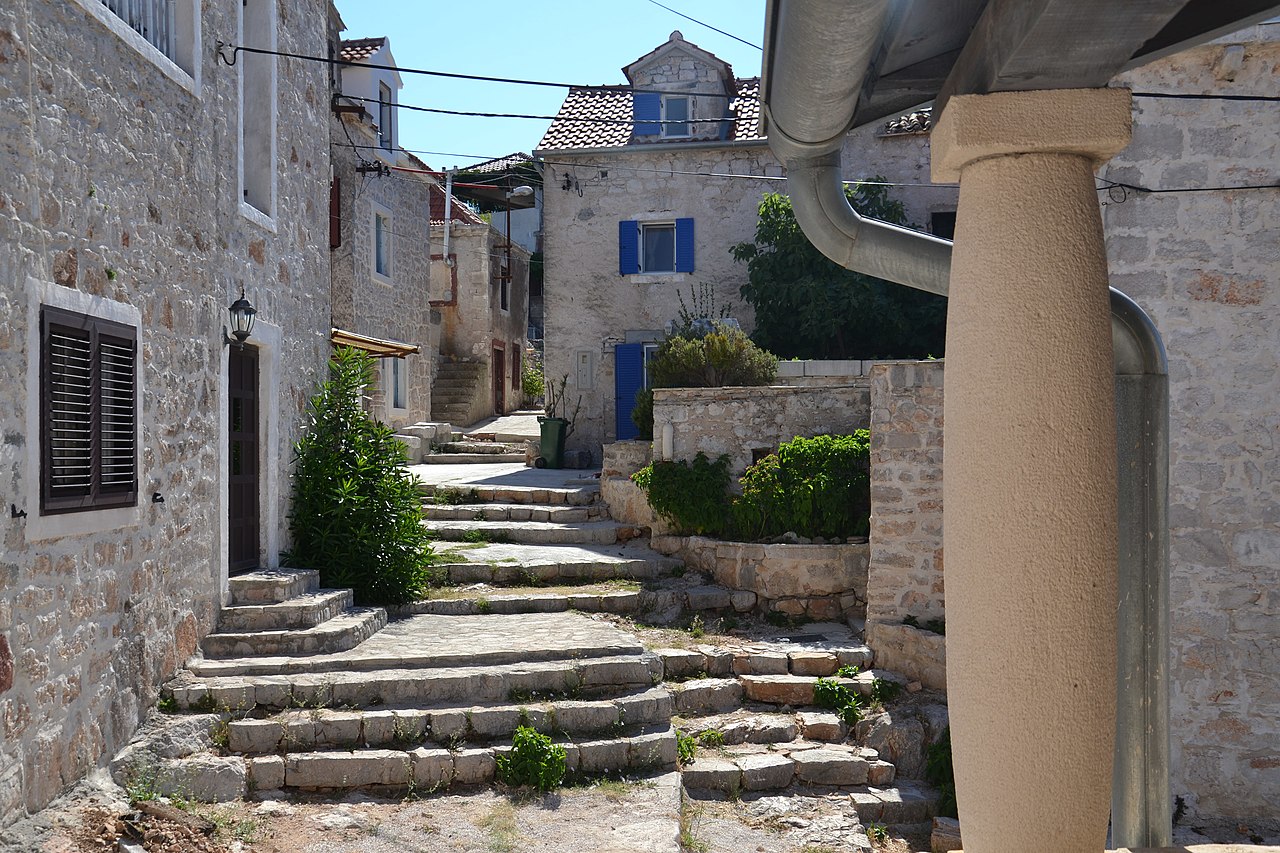
Photo: Roman Klementschitz/Wikimedia Commons
Obonjan
Obonjan is a small island located east of the island of Zlarin. Starting July 1st, one ferry will depart from Šibenik on Mondays, Wednesdays, and Fridays in the direction of Obonjan, via line 532 (Šibenik - Zlarin - Kaprije - Žirje). The ferry departs at 8:30 am and arrives in Obonjan at 9:10 am. The price of the ferry ticket for adults is 25 kunas, while for children (from 3 to 12 years old) it is 12.5 kunas.
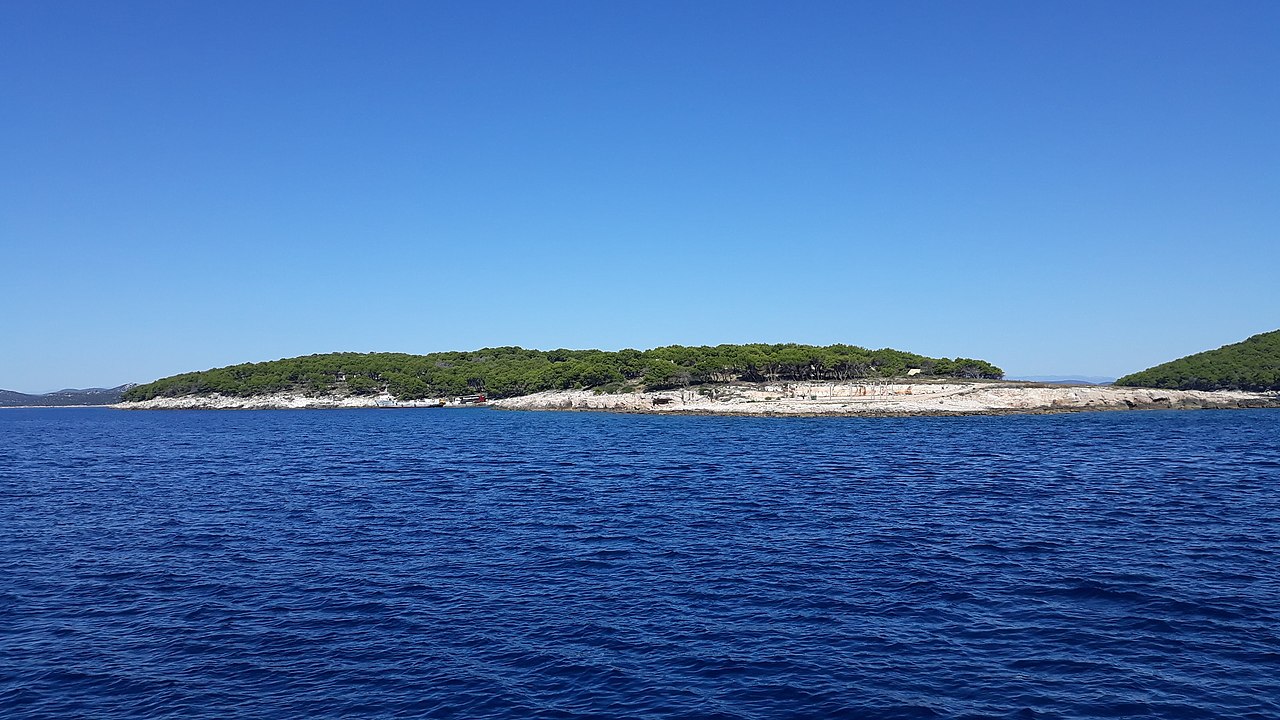
Photo: Ante Pletikosić/Wikimedia Commons
Prvić Luka
Prvić Luka is located south on the island of Prvić, one of the first islands after crossing the Saint Ante channel.
Every day, ships leave Šibenik for Prvić Luka. From Monday to Saturday, up to five trips are made on line 505 (Vodice - Šibenik), while on Sundays only three. From Monday to Saturday, the schedule of the ships leaving Šibenik for Prvić Luka is as follows: the first one leaves at 5:30 am and arrives at 6:25 am, the second one leaves at 9:30 am and arrives at 10:20 am, the third leaves at 12:40 pm and arrives at 13:20 pm, the fourth leaves at 15:40 pm and arrives at 16:20 pm, and the fifth and last ship leaves at 19:30 pm and arrives at 20:05 pm. The Sunday schedule is as follows: the first ship leaves at 6:35 am and arrives at 7:35 am, the second leaves at 9:00 am and arrives at 9:35 am, and the third and last ship departs at 20:45 pm and arrives at 21:25 pm.
The price of the ferry ticket for adults is 25 kunas, while for children (from 3 to 12 years old) it is 9 kunas.
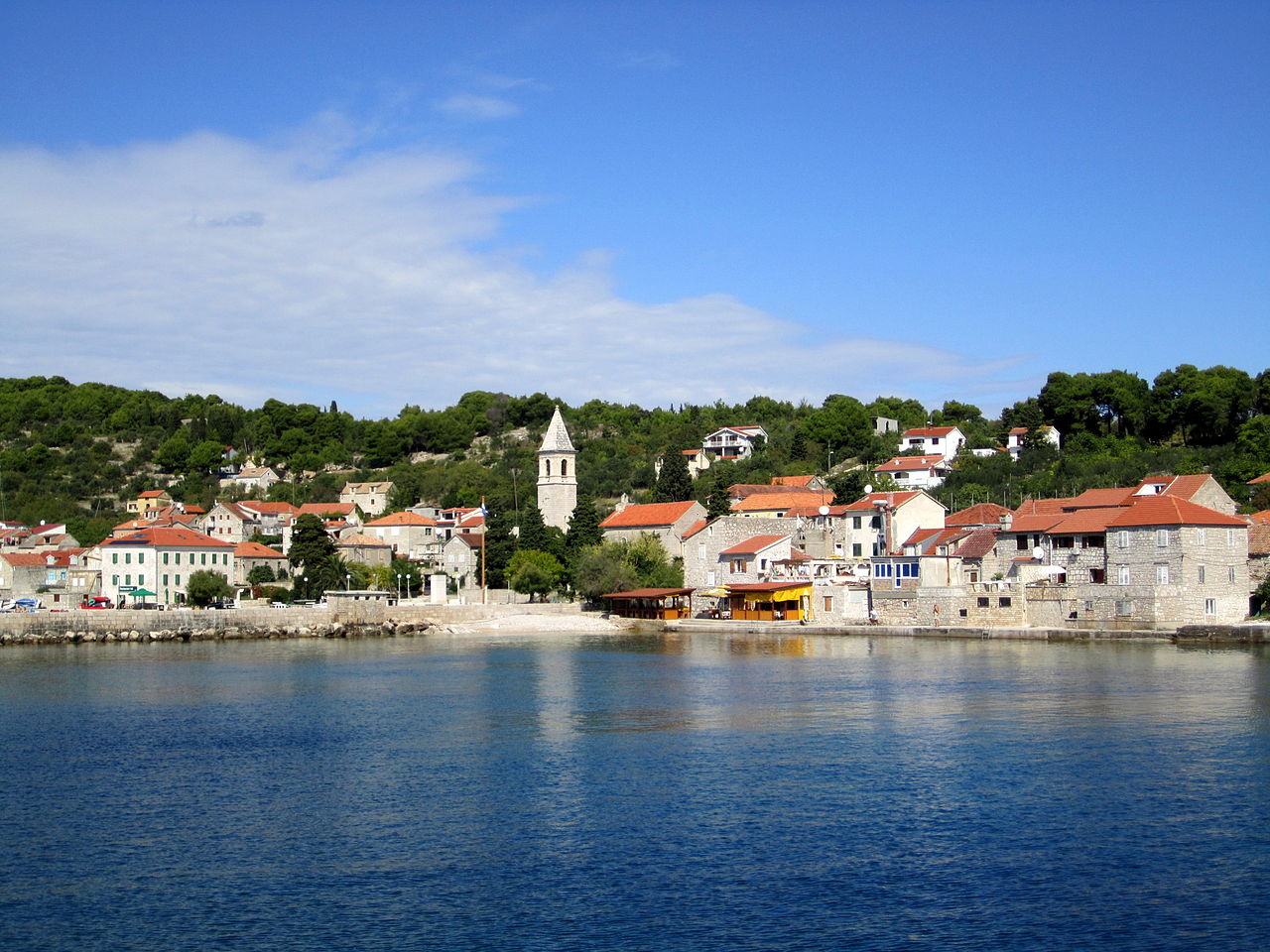
Photo: Andres rus/Wikimedia Commons
Šepurine
Šepurine is another destination on the island of Prvić, but further north. As with Prvić Luka, line 505 (Vodice - Šibenik) is the one that goes to Šepurine.
The frequency of boat trips is the same: five from Monday to Saturday, and three on Sundays. The schedule of the boats from Monday to Saturday is as follows: the first one leaves at 5:30 am and arrives at 6:10 am, the second one leaves at 9:30 am and arrives at 10:40 am, the third leaves at 12:40 pm and arrives at 13:35 pm, the fourth leaves at 15:40 pm and arrives at 16:35 pm, and the fifth and last ship leaves at 19:30 pm and arrives at 20:20 pm. The Sunday schedule is as follows: the first ship leaves at 6:35 am and arrives at 7:20 am, the second leaves at 9:00 am and arrives at 9:50 am, and the third and last ship departs at 20:45 pm and arrives at 21:40 pm.
The price of the ferry ticket for adults is 25 kunas, while for children (from 3 to 12 years old) it is 9 kunas.

Photo: Hschermer/Wikimedia Commons
Vodice
Unlike other ports that we have covered in this series of articles, the port of Šibenik also has a ferry connection to a destination that is not an island: Vodice, located north of the city.
Line 505 (Vodice - Šibenik) offers four daily trips from Monday to Saturday, while only three on Sundays. The schedule of the boats from Monday to Saturday is as follows: the first one leaves at 9:30 am and arrives at 11:00 am, the second leaves at 12:40 pm and arrives at 13:50 pm, the third leaves at 15:40 pm and arrives at 16:50 pm, and the fourth and last ship leaves at 19:30 pm and arrives at 20:45 pm. The Sunday schedule is as follows: the first ship leaves at 6:35 am and arrives at 7:05 am, the second leaves at 9:00 am and arrives at 10:15 am, and the third and last ship departs at 20:45 pm and arrives at 22:00 pm.
The price of the ferry ticket for adults is 26 kunas, while for children (from 3 to 12 years old) it is 11 kunas.
Zlarin
Zlarin is one of the largest islands in the Šibenik archipelago, known for its quiet beaches and historic port.
The ferry line 505 (Vodice - Šibenik) is one of Jadrolinija's lines that takes passengers to the island of Zlarin. From Monday to Saturday, five trips are made from the port of Šibenik, and four on Sundays. The schedule of the ships leaving Šibenik for Žlarin is as follows: the first one leaves at 5:30 am and arrives at 6:40 am, the second one leaves at 9:30 am and arrives at 9:55 am, the third leaves at 12:40 pm, and arrives at 13:05 pm, the fourth leaves at 15:40 pm and arrives at 16:05 pm, and the fifth and last ship leaves at 19:30 pm and arrives at 19:50 pm. The price of the ferry ticket for adults is 25 kunas, while for children (3 to 12 years old) it is 9 kunas.
On Tuesdays and Thursdays, there is an additional trip of ferry line 532 (Šibenik - Zlarin - Kaprije - Žirje), which departs at 11:30 am from Šibenik and arrives in Zlarin at 11:55 am. The price of the ferry ticket for adults is 25 kunas, while for children (3 to 12 years old) it is 12.5 kunas.
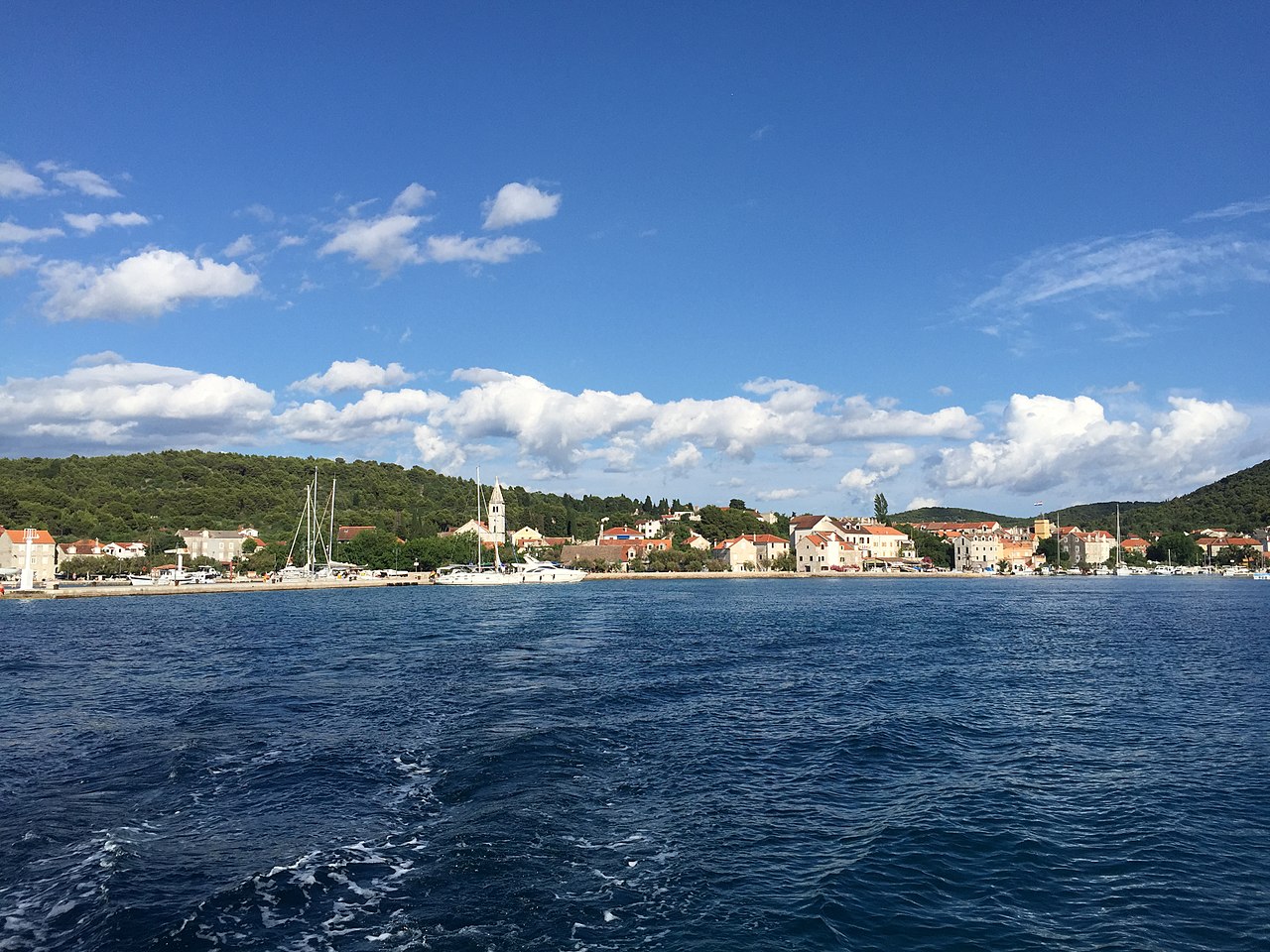
Photo: Luboš Holič/Wikimedia Commons
Žirje
The island of Žirje is the farthest from the port of Šibenik. To reach the island of Žirje, two ferries on line 532 (Šibenik - Zlarin - Kaprije - Žirje) leave every day. The first departs from Šibenik at 11:30 am and arrives at 13:10 pm, and the second leaves at 16:30 pm and arrives in Žirje at 18:10 pm. The price of the ferry ticket for adults is 26 kunas, while for children (from 3 to 12 years old) it is 11 kunas.
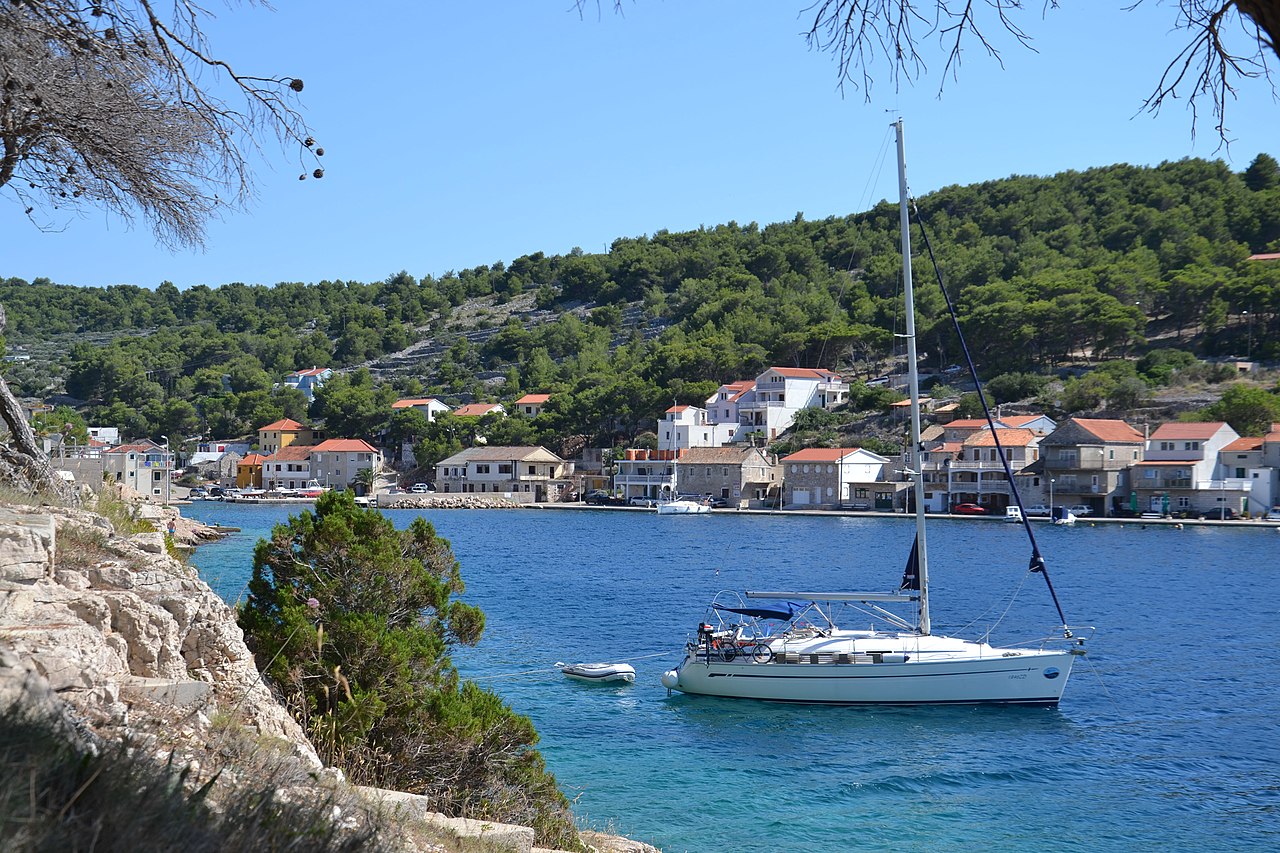
Photo: Roman Klementschitz/Wikimedia Commons
The ferry lines mentioned above are those with confirmed schedules for the next three months. Prices are subject to change. Visit the official Jadrolinija website for more information on other ferry lines from Šibenik.
For more on travel in Croatia, follow TCN's dedicated page.
Zlarin Island Has Least Plastic, Most Waste Separation on Krk Island
June the 12th, 2022 - Zlarin island has the least plastic waste among the country's many inhabited islands, while the island of Krk does the best job when it comes to waste separation.
As Morski writes, the Sunce Association organised another study trip as part of the project entitled "For Plastic-Free Croatian Islands". This time, the employees of the Sunce Association, along with their project partners, visited the island with the least plastic, Zlarin island, and the island with the highest percentage of waste separation in all of Croatia, Krk.
The first day of the trip was a visit to Zlarin island, which launched the initiative to reduce plastic waste on that particular island four years ago.
''Through the initiative For Zlarin island without plastic, significant progress has been made in reducing pollution as a result of disposable plastic. The project was initially supported by the Tourist Board and the local mayor, and then slowly began to involve local traders, fishermen and other locals,'' said Katarina Gregov, a representative of the Zlarin Tourist Board.
The mere fact that there are no cars on Zlarin island is a sufficient motivator for the local community to continue striving to develop the concept of sustainable tourism by which visitors have the opportunity to experience the island as it always has been throughout time.
''Our goal is to make people aware of being more responsible consumers and not replacing one type of waste with another. In the beginning, of course, it wasn't easy, it's difficult to change people's already well established habits and patterns of behaviour. However, when you provide them with some education, and at the same time an acceptable and affordable alternative to disposable plastic, most of them eventually agree to it,'' said Katarina.
Krk - the island with the highest percentage of separated waste in all of Croatia
The second and third day of the trip saw the aforementioned Association head to the beautiful island of Krk, the most populated and economically developed island in the country, and also one of the Croatian leaders in the share of separation of useful raw materials from waste.
For many years, Krk has been implementing a system of a circular economy, which doesn't discard raw materials, but instead uses them for re-production. This reduces the consumption of limited natural resources (oil, wood, iron) and, consequently, waste.
Waste is collected door to door, and Krk's residents have bins in front of their houses in order to separate plastic, glass, paper, biowaste and mixed municipal waste themselves. However, the door-to-door waste collection system wasn't introduced in the old town due to the mayor's decision not to have bins located there, nor air conditioning, clotheslines, etc. That means that waste from the old town is collected outside the of the walls in special locations.
A large amount of separately-collected recyclable waste comes mixed, so this waste is first taken to a sorting plant where it's further sorted, baled and handed over for further recovery. Additional waste sorting is important when it comes to separating waste that doesn't belong there. In addition, waste sorting plants are important for the future self-financing of utility companies because they further reduce the cost of waste collection.
Krk is also proud of its modernly equipped composting plant, in which about six million kuna was invested two years ago for the modernisation of the plant. The space of the once open composting plant, after the investment, was covered and closed, and a device for machining the imported biowaste was installed in it. Produced compost is 1st class compost used for agricultural purposes, and users of Ponikve Krk's services receive one bag of that compost as a gift, while larger quantities are sold at a very affordable price and brought to the doorstep. Ponikve Krk also plans to produce third class compost from sludge from wastewater in the amount of 676 tonnes of compost per year.
For more, make sure to check out our dedicated lifestyle section.
Zlarin: Croatian Coral Centre Should be Completed This Year
April the 24th, 2022 - The Croatian coral centre in Zlarin close to Sibenik should finally be completed by the end of this year, sources claim.
As Morski writes, a contract on the public procurement of a permanent exhibition for the Croatian Coral Centre in Zlarin has now been signed. The value of the contract stands at 2.9 million kuna without VAT, and the deadline for the execution of the contract is seven months.
The process of purchasing a permanent exhibition was launched back in August last year, and it included the designing of the said permanent exhibition, preparing all of the necessary documentation required for the implementation of the exhibition, as well as the supply, transport and installation of all of the designed content and educating users to work with the system.
In addition to representatives of the City of Sibenik, experts in the field of architecture, coral protection and museology participated in the review and evaluation of all of the bids.
The selection criterion for the upcoming Croatian coral centre in Zlarin was the most economically advantageous bid, with the bid price being assessed as the financial criterion (40%) and the non-financial quality criterion as the non-financial criterion (60%).
''The procurement took a relatively long time because, as is most often the case with and in Sibenik, we decided to take a more difficult path in order to get the best possible solution. We hope that this exhibition will fulfill its purpose, because the revival of the Croatian coral centre depends on the visitor dimension and the impressions of guests.
It's an exhibition for visitors in which the protection of nature is generally emphasised, without ignoring, but rather respecting and valorising the rich history of Zlarin, its cultural heritage and numerous artists from Zlarin, such as Vesna Parun, or those who are connected with this island,'' said Petar Misura, the head of the Administrative Department for Economy, Entrepreneurship and Development of the City of Sibenik.
According to Ivana Katuric, the director of the selected Split company (Urbanex), the innovative permanent exhibition of the Croatian Coral Centre in Zlarin will be at a high European level.
For more, check out our lifestyle section.
Croatian Traditional Jewellery: Coral, Silver and Gold in Dalmatia
February 26th, 2022 - Following our feature dedicated to traditional jewellery of Istria, a look at the intricate filigree pieces traditionally worn in Dalmatia
In the first part of this series, we wrote about medieval jewellery discovered in Istria that has only recently seen a revival in the form of artisan replicas.
The traditional jewellery of Dalmatia, however, has historically been an integral part of folk costumes all over the region, and has been worn and treasured by generations of women up to the present day.
Let's take a look at some of the most prominent designs found in Dalmatia:
Pag beaded necklace and earrings / Paški peružini i ročini
First, a quick disclaimer: depending on who you ask, Pag island is a part of Kvarner, Dalmatia, neither, or both. We'll leave the people of Pag to define their cultural identity as they see fit, and will include the island in this particular feature based on the shared traits of traditional jewellery of Pag and that found in the rest of Dalmatia.
The traditional costume of Pag island largely owes its distinctive appearance to the triangular headdress worn by women, made of starched white linen and lined with intricate lace.
The Pag lace is a showstopper, but if you take a closer look, you’ll see that the ladies are also adorned in jewellery when clad in traditional garb. It’s been worn on Pag since the 16th century, and considering that there were no master goldsmiths living on the island at the time, the jewellery was imported from Venice.
 Pag folk costume / Image by Hotel Biser
Pag folk costume / Image by Hotel Biser
There are two distinct types of jewellery worn as part of the Pag folk costume. Delicate beads made in the filigree technique are called peružin; string a number of them together and you get a gorgeous necklace. Decorative hair pins featuring a single peružin were used to help keep the headdress in place, as seen on the above photo. It should be mentioned that the traditional peružini were once made to weigh exactly 123 grams each!
 A modern replica of Pag peružini / Image by Zlatarnica Jozef Gjoni
A modern replica of Pag peružini / Image by Zlatarnica Jozef Gjoni
The other distinctive piece found on Pag are the ročini, dangly bell-shaped earrings typically made of silver or gold.
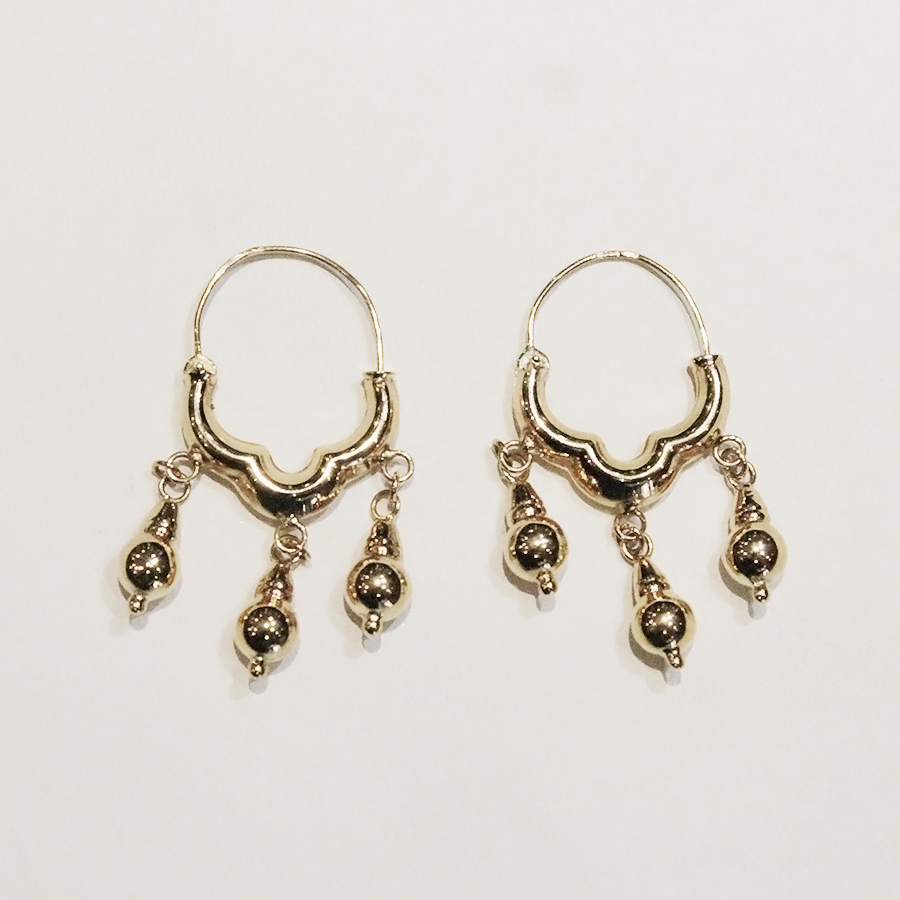 A modern replica of Pag ročini / Image by Zlatarnica Jozef Gjoni
A modern replica of Pag ročini / Image by Zlatarnica Jozef Gjoni
Šibenik button / Šibenski botun
Arguably the most popular piece on this list, the intricate Šibenik button used to be a decorative part of men’s folk costumes. These days, it’s one of the most recognisable symbols of Šibenik that doubles as an authentic souvenir. And while the motif is still seen in men’s accessories - tie clips, cufflinks - it’s not exclusive to gents anymore and is featured in women’s jewellery as well.
Similar to the Pag peružin, the Šibenik button is a hollow filigree bead composed of two half-spheres bonded together. Traditionally, the button used to be made of silver, but nowadays you’ll also find modern replicas made of gold, rose gold and aluminum. It's also called puce and toka, and was known to come in different sizes and designs depending on intended use.
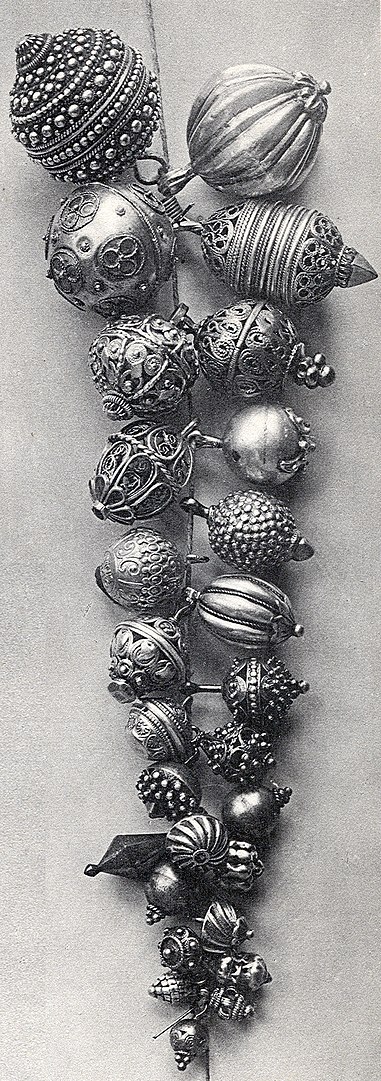 Various versions of Šibenik buttons
Various versions of Šibenik buttons
Even though there are metal buttons discovered in Dalmatia that date back to ancient times, the famous decorative bead only became widely adopted as a part of traditional garb around the 17th century.
As mentioned, they were only worn by men back then and were an indicator of social status and rank. The buttons were essentially comparable to military medals, as they were awarded to heroes and commanding officers from the region by Venetian generals based in Zadar.
Over time, the Šibenik button became so popular that a large number of artisans, from northern Dalmatia all the way to Albania in the south, specialised in the filigree technique so that they could create the intricate orbs.
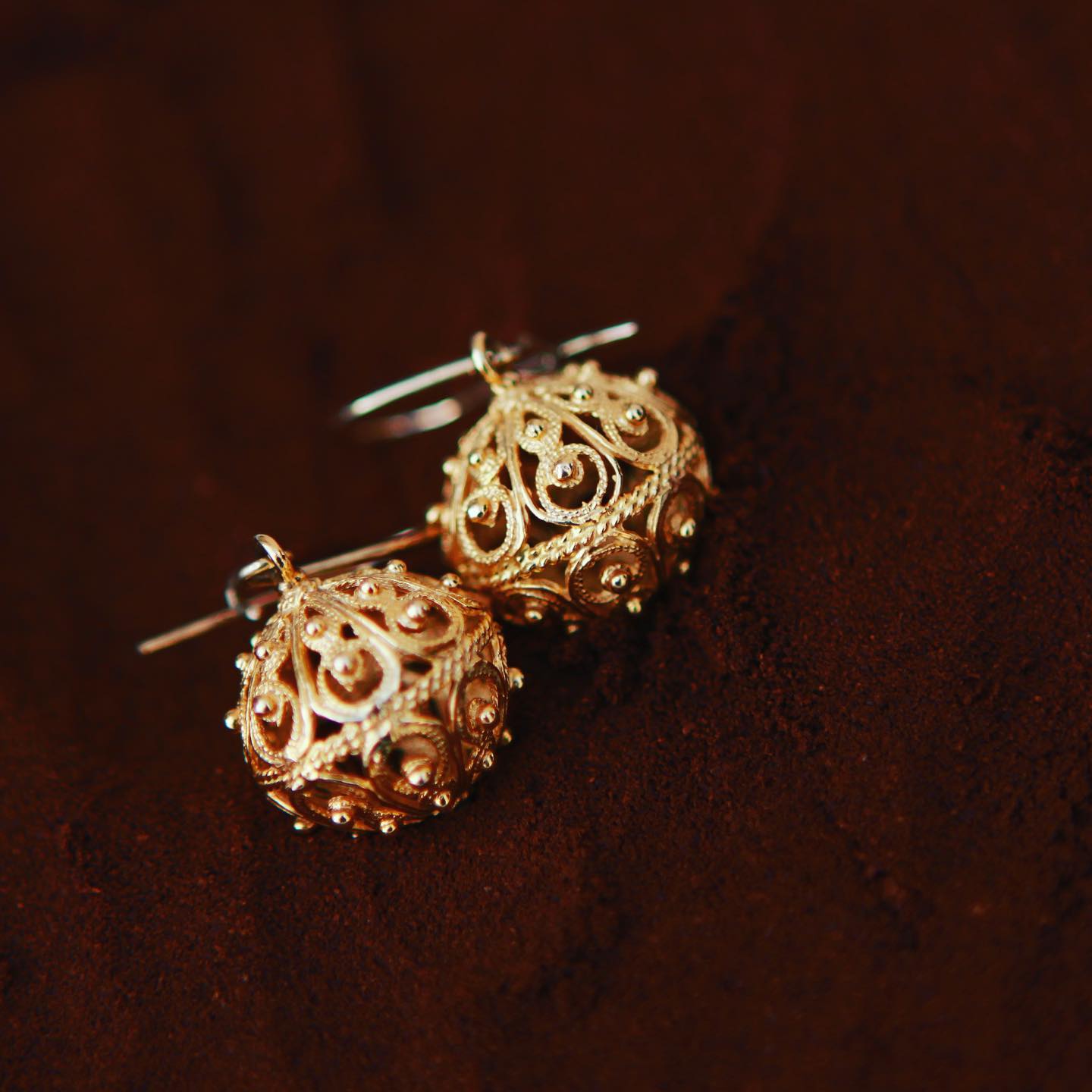
Šibenik button earrings / Image by Zlatarnice Rodić Facebook
Zlarin coral / Zlarinski koralji
For a little intermezzo on our filigree-laden tour, we’re heading to Zlarin island right off the coast of Šibenik, historically known for quite a specific thing: coral.
People of Zlarin have dealt in coral harvesting and processing since the 14th century; while harvesting isn’t that common anymore, Zlarin is still home to a handful of skilled artisans creating unique coral jewellery.
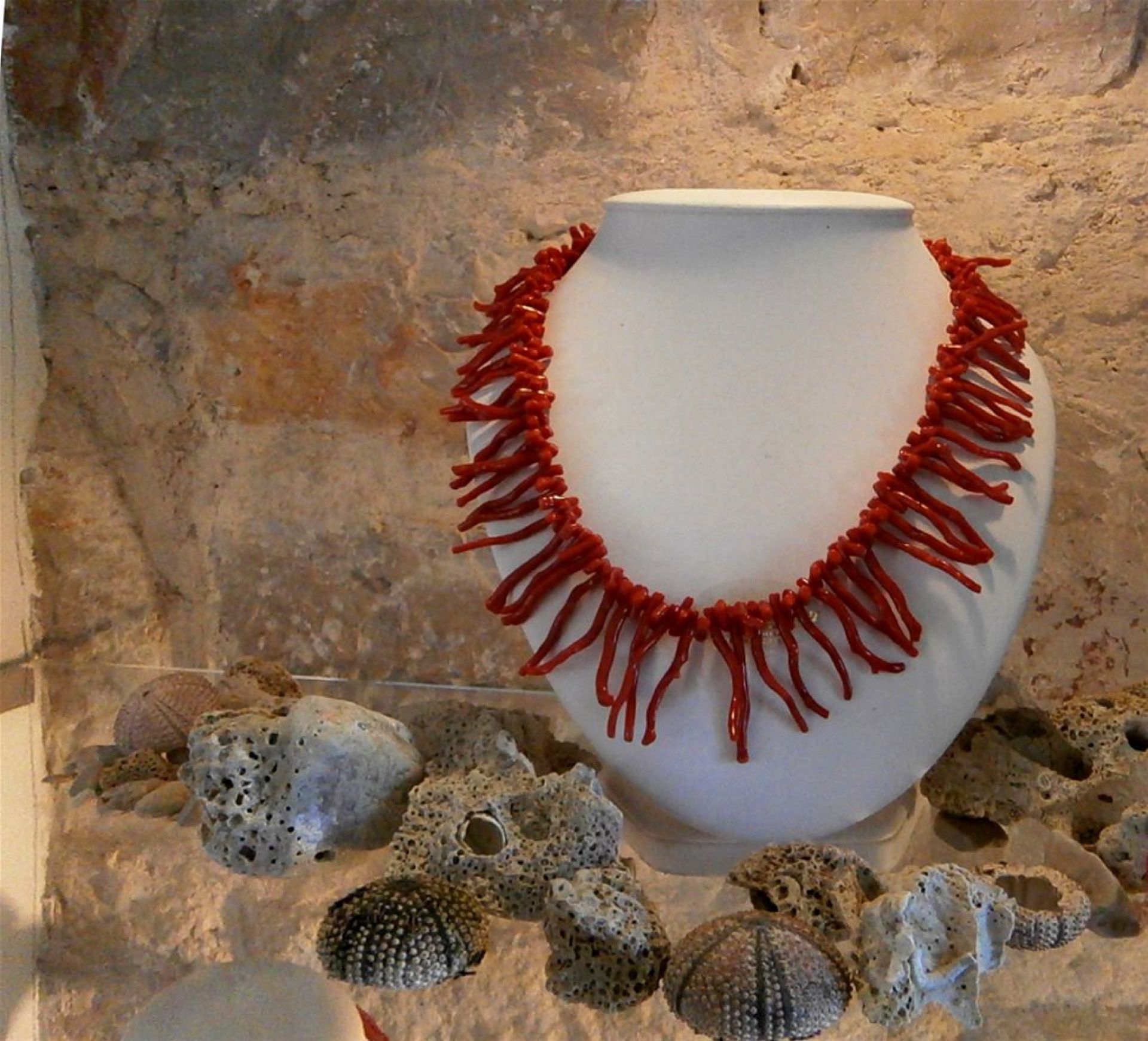 Red coral necklace / Šibenik Tourist Board
Red coral necklace / Šibenik Tourist Board
Red coral, also called precious coral, thrives in clean waters and grows at the depth of 30 to 200 metres. In its natural state, it’s covered in a crust that needs to be filed down for its intense red colour to show; the skeleton is then cut into smaller pieces, each of which gets filed, shaped and polished. Polishing is the most crucial stage, a process that can last up to a few days and results in a high shine. The colour has a range of 10-15 hues, varying from a light to a deep red.
The art of coral harvesting was a skill passed from father to son. Coral was historically harvested by trawling, using a tool called inženj, a wooden cross weighed down with a heavy stone and fitted with fishing nets. Coral would get entangled in the nets as they dragged across the seabed and break off when the nets were pulled out of the sea.
Fishermen from Zlarin participated in harvesting expeditions all over the Adriatic - sometimes straying even further, as far as Greece - and sold the catch on Sicily.
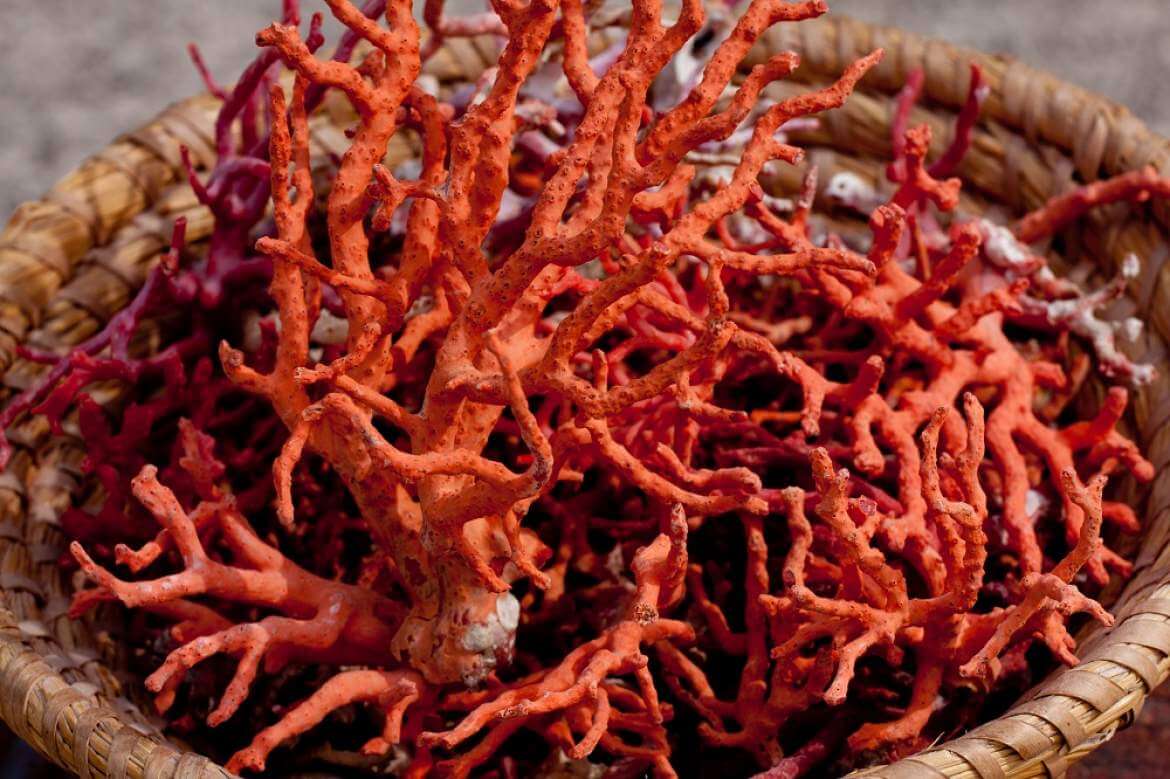 Red coral / Zlarin Tourist Board
Red coral / Zlarin Tourist Board
After the fall of the Venetian Republic that controlled the coral trade in the Adriatic, the people of Zlarin were granted the exclusive right to coral fishery. Like elsewhere in the Mediterranean, coral was overharvested due to its value until it was nearly eradicated, and so the practice gradually became less common by the mid-20th century.
Nowadays, the island is home to two coral shops run by jewellery makers that keep the tradition alive. Zlarin is also about to get a Croatian Coral Centre, a state-of-the-art facility dedicated to the island’s history of coral harvesting that's set to open sometime soon.
Konavle earrings / Konavoske verižice & fjočice
We’re heading further south, to the Konavle area near Dubrovnik, the home of the elegant Konavle earrings.
The verižice hoop earrings from Konavle have a small pendant, typically a pearl or a coral bead. In the olden days, there was a social order to wearing jewellery in Konavle: young girls wore smaller earrings, and the older the women got, the bigger earrings they could wear. Young men were known to present their brides with the lovely hoops as a gift before their wedding day.
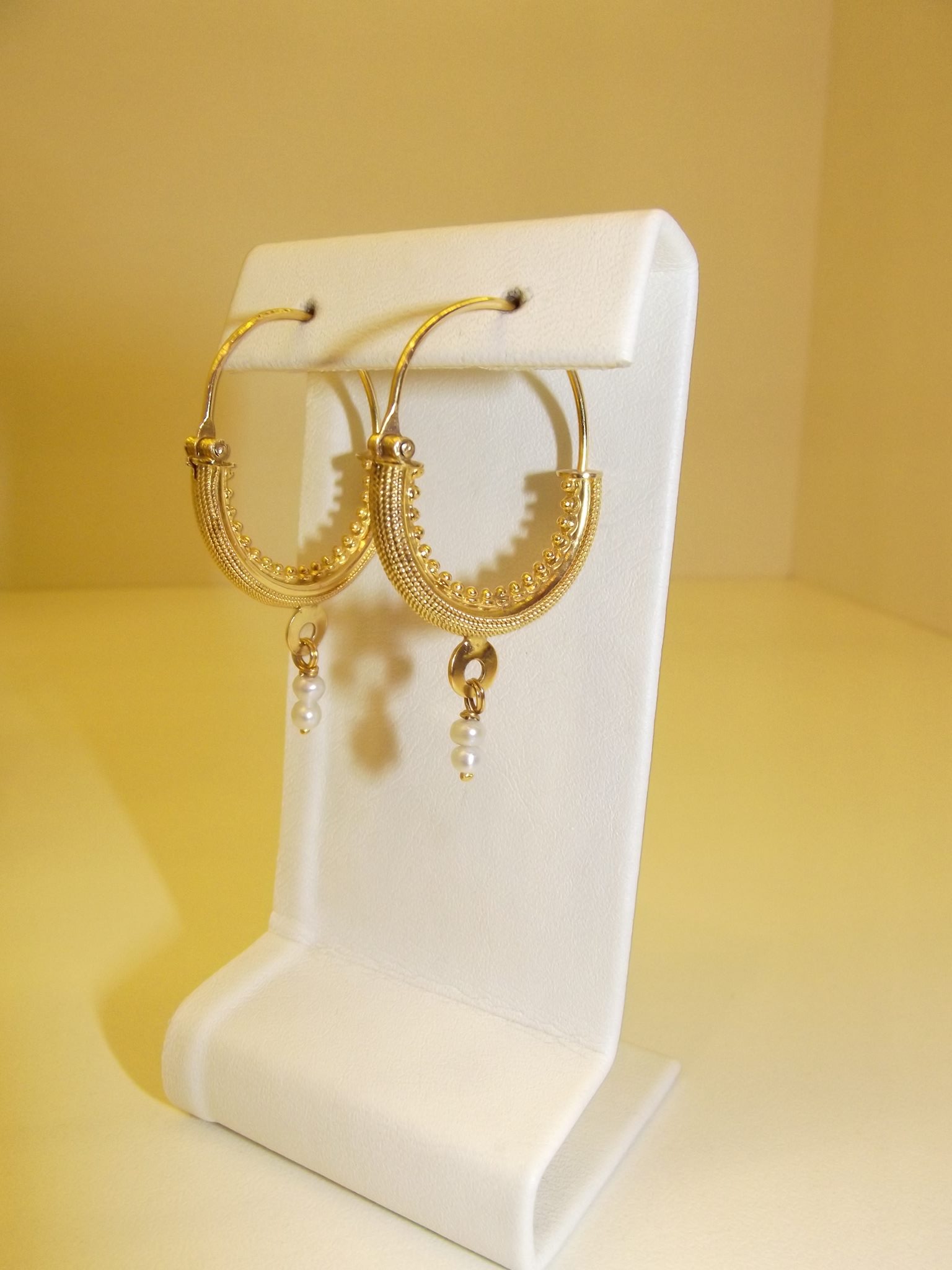 Modern replica of Konavle earrings / Image by Zlatarnice Rodic Facebook
Modern replica of Konavle earrings / Image by Zlatarnice Rodic Facebook
Traditional jewellery was handled with care and kept in decorative wooden boxes or in special compartments in chests. The best pieces were only worn in rare special occasions, as jewellery was considered a family heirloom and was passed down from generation to generation.
Another type of earrings popular in Konavle are the so-called fjočice. Worn by brides on the day of their wedding and in the first year of marriage, the dangly earrings had several pendants made in gold filigree.
The Croatian Post paid homage to the lovely fjočice with their own postage stamp, created by designer Alenka Lalić from Zagreb:

Interestingly, the Konavle earrings weren’t actually made in the Konavle area, but were instead manufactured by goldsmiths in Dubrovnik. In the 19th and 20th centuries, the goldsmith workshops predominantly focused on traditional jewellery, driven by the increasing demand from Konavle and the wider Dubrovnik area.
Dubrovnik necklace / Dubrovačke peružine & kolarin
As Dubrovnik used to be a major goldsmithry centre from the medieval times to the mid-20th century, it doesn’t come as a surprise that the Pearl of the Adriatic has its own type of traditional jewellery.
You’ll surely recognise the peružin motif by now, the hollow filigree beads which in Dubrovnik were traditionally made of gold. Strung together, the beads make a lavish necklace called kolarin.
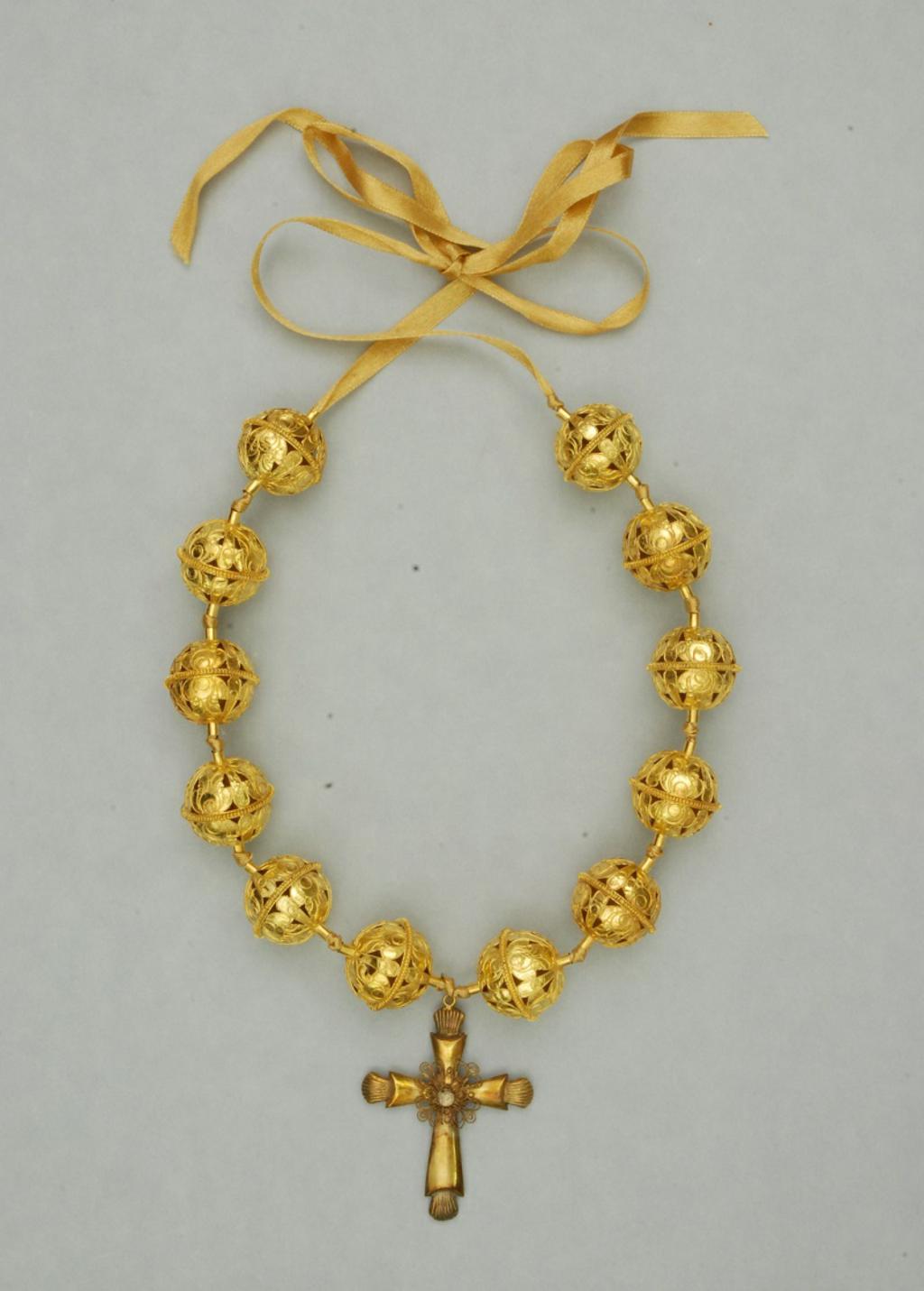
The kolarin were most commonly composed of 12, 14, 16 or 18 peružin beads, either simply strung on a silk ribbon, or connected with small golden links, pearls or coral beads. They were known to feature a heart-shaped pendant or a golden cross, altogether making a show-stopping piece typically worn on special occasions.
Nowadays, you'll most commonly find earrings or pendants featuring the Dubrovnik peružin bead.
Archipelago without Plastic: Krapanj and Zlarin Islands Moving Away from Disposable Plastics!
July 4, 2021 - After almost three years of successfully implementing the initiative "For Zlarin without plastic", the initiative "Archipelago without plastic" opened in Krapanj and Zlarin this weekend, marking the International Day without plastic bags and the European Union Directive on Disposable Plastics in Croatia.
"For Zlarin without plastic" is an initiative initiated by Ana Robb, Nataša Kandijaš, Ivana Kordić, and Jelena Radošević to stop the use of disposable plastic on the island, making Zlarin the first Croatian island free of disposable plastics, reports HRTurizam.
The initiative was recognized and received great media attention, but also numerous awards, and with new partners - the association "Together for Krapanj" and the Tourist Board Krapanj-Brodarica, the project "Archipelago without plastic" designed a way to spread the Zlarin example to other islands - for a start, on Krapanj.
"In the past three years, the island of Zlarin has made significant progress in reducing pollution with disposable plastics, but also a shift towards the concept of sustainable tourism through which we provide visitors with summer content in the summer season," said Tatavaka and Together for Krapanj, which are launching this new initiative in cooperation with the Zlarin and Krapanj-Brodarica tourist boards.
The program will start on July 4 in Krapanj at the Hotel "Spongiola" with the signing of the Charter on Krapanj without plastic, and at the same time, the trabaccalo Desto of the Cukrov family, who are co-signatories of the Charter, will dock in the port of Krapanj. This 120-year-old wooden trabaccalo has survived the dominance of plastic ships, and on this occasion, it will become a mobile gallery of the artist Sanja M. Vukman and her exhibition of ecological signs entitled "Objects of an imaginary traveler through the archipelago of dreams".
The presented personal belongings of the imaginary traveler are real props for traveling through the archipelago experienced through the process of research and contemporary interpretation of traditional living. The exhibits are useful objects, field samples, seeds, working materials in the process, fragments, and fragments connected by the same longing to live the daily available poetry of small things.
Island caterers and other small entrepreneurs who primarily depend on the reduction of plastic distribution will sign the "Charter of Krapanj without plastic" and thus become the first island with which the adventure of "Plastic-free archipelago" begins.
The initiative is supported by the City of Šibenik, as a partner in the BeMed program project, as well as the Šibenik-Knin County. The project partner and support at the international level is SMILO - Small Island Organization, while the initiative is supported by Julije Domac, President of the Energy Transition Council of the President of the Republic of Croatia and Director of REGEA who will join the opening and "Island Movement" as a network organization island communities of Croatia.
The associations are especially proud of the cooperation with the ambassador of the "Archipelago without plastic" - Domagoj Jakopović Ribafish, whose project "RokOtok" symbolically connects Krapanj, Zlarin and - as the next step - the island of Prvić. Ribafish will start the implementation of this year's "RokOtok" edition by swimming between Brodarica and Krapanj, and will hold workshops for children in Krapanj and Zlarin.
For more, follow our lifestyle section.
Military Helicopter Crashes into the Sea near Zlarin, Croatia
January 27, 2020 - A military helicopter has reportedly crashed into the sea off the island of Zlarin, according to a report from HINA.
Reports are still coming in, but it has been confirmed that the helicopter crashed into the sea at 11:06 this morning on a flight from Zablac to Zlarin.
It is not known how many people were on board, though Šibenik.in has reported that the body of the helicopter crew member was pulled from the sea. A forensic unit also arrived in Zablace waterfront.
Two naval police boats have been dispatched to the scene.
The Ministry of Defense held a press conference at 2:30 pm in Zemunik. Deputy Prime Minister and Minister of Defense Damir Krsticevic, Chief of General Staff of the CAF General Corps Mirko Sundov and Commander of the Croatian Air Force Brigadier General Michael Krizanec headed for Zemunik. The Ministry of Defense confirmed that a Croatian Air Force pilot, a member of the Kiowa Warrior helicopter crew, was killed in a Kiowa Warrior helicopter crash into the sea in the Zlarin Channel in front of Zablace.
“There were two crew members in the Kiowa Warrior helicopter. An intensive search and rescue operation was launched for the other crew member, which included a Croatian Air Force helicopter and the Croatian Navy Coast Guard, as well as operational services of the Ministry of the Interior and a rescue ship from the Šibenik Harbor Master's Office. The Ministry of Defense, the Croatian Armed Forces, and the Croatian Air Force are deeply shaken by the unfortunate event and express their condolences to the family of the deceased member of the Croatian Air Force," said the MOD.
"For now, the Kiowa military helicopter with two crew members crashed for an unknown reason. All measures and actions were immediately taken to find and rescue the crew, and one pilot, who was found, had passed,” Defense Minister Damir Krsticevic said at the press conference, expressing his deepest condolences to the family.
The helicopter was on a training flight, which started at 10:30.
The helicopter, a Kiowa OH-58 D, had apparently recently been donated to the Croatian Army by the United States.
More on this story as we get it.
City of Šibenik to Eager to Begin Croatian Coral Center on Zlarin Island
August 20, 2019 - The Croatian Coral Center project on the island of Zlarin off Šibenik is worth over 24 million kuna.
The City of Šibenik has thus opened a public procurement procedure for the renovation of the Šare and Kažerma houses with an access road, as part of the Zlarin Croatian Coral Center project. The estimated value is HRK 8,193,109.40, excluding VAT, reports HRTurizam.
This investment will form the infrastructure backbone of the Croatian Coral Center on Zlarin, and will form the basis for the sustainable use of natural heritage and more efficient management of visitors to the island of Zlarin and the surrounding area, the City of Šibenik said.
Four floors of the Kažerma house with a total area of 452.98 m2 will be renovated, as well as three floors of the Šare house, with a total net area of 204.52 m2. Additionally, a courtyard between these houses of 87.50 m2 will serve as a presentation and educational center. A road will be reconstructed, which leads from the coast to the houses and physically connects them.
The project to establish the Croatian Coral Center on Zlarin involves the renovation of the Šare and Kažerma houses. The Kažerma house will function as a showroom with a permanent display that will include an ecosystem display and protected species of the Šibenik archipelago, the Zlarin coral tradition, and a library with scientific works and poetry by Vesna Parun. The entire permanent exhibition will be equipped with modern technologies such as augmented reality, kinetic figures, and other audiovisual attractions. The Šare house will be transformed into an educational research center with an amphitheater and accommodation units for researchers and scientists.
The project will also establish a system for monitoring the movement of visitors, carry out monitoring of coralligenous biocenosis, purchase electric vessels and vehicles for the transportation of visitors, create a set of unique souvenirs of the Croatian Coral Center Zlarin, conduct training on the functionality of the center for staff of the center and partners, develop educational and tourist programs, and develop the brand of the future center.
The project will also work on exploring the sea of Šibenik-Knin County with an emphasis on corals, as well as educating tourism staff about the importance of the sites themselves. The total value of the project is HRK 24,127,147.50.
To read more about lifestyle in Croatia, follow TCN’s dedicated page.
Forbes Praises Adriatic Hotel and Zlarin Island for Not Using Disposable Plastic
Croatia is a favourite holiday destination for many, and numerous tourists discover the beauty of Croatia again and again. While foreign media often writes about Croatia as a dream destination, praises for environmental protection are somewhat less common. However, the renowned Forbes magazine has published a story about the Adriatic Hotel in Rovinj, part of the Maistra Collection brand, which recently decided to replace all disposable plastic items with available alternatives, which means it will become the first hotel in Croatia that is actively committed to a cleaner environment and the no-plastic-waste vacation principle. The campaign was launched on April 22, the Earth Day.
“Every human should take responsibility to protect the environment where we live, work and travel. Here in Rovinj, we have hotels right above a beautiful bay, next to a protected forest of centenary trees and on the main town square,” says Lovorka Struna, Maistra’s hotel director, as quoted by Forbes. “With this long-term initiative, we want to preserve this uniqueness and beauty, since it is ultimately about our shared future.”
As the first hotel in Croatia without disposable plastic, the Adriatic Hotel strives to be a leader in innovation and sustainability. Last year, it started using substitute paper straw instead of plastic ones, and by June the hotel will cease using 80 per cent of disposable plastic products. By the end of the year, it will have completely eliminated them from all accommodation units, bars and restaurants.
“We want to create a mindset where people will naturally refuse disposable plastics that are used for a few minutes but can last in the environment for centuries,” explains marine biologist Chiara Fumagalli, a project partner involved in the Adriatic for Adriatic campaign, as quoted by Forbes. “The idea is to inspire businesses, individuals and governments to follow suit, start a dialogue and raise awareness about the plastic pollution problem.”
The similar drive has been launched on the small island of Zlarin, which aims to become the first island in Croatia that will not use single-use plastics.
In March, the small Dalmatian island signed a charter that regulates that entrepreneurs on the island will not use disposable plastic such as bags, plates, cutlery, straws and cups. Plastic is an increasing threat to Zlarin, as a small number of inhabitants of the island face a large-scale increase in the number of tourists and guests during the summer months. About 15,000 plastic bags end up in the garbage, and plastic also pollutes the sea.
“As proof of its dedication to the cause, Croatia is hosting the very first edition of the Plastic Ocean Summit in March 2020 on the island of Mali Lošinj. It’s organised by the Ocean Alliance Conservation Member (OACM) group, a conglomerate of countries that have united to protect, preserve and clean the oceans, lakes and rivers. These are impressive major steps for a small country taking a stance against one of the world’s biggest problems,” writes Forbes.
More environmental news can be found in the Lifestyle section.
Croatian Coral Centre Coming to Zlarin
In July 2018, the City of Šibenik started with the implementation of the project of the Croatian Coral Centre on the island of Zlarin. This is another project that will be realised in the Šibenik area with non-refundable EU grants. The total value of the project is 24 million kuna, including a grant worth 13 million kuna, reports Lokalni.hr on March 19, 2019.
The Šibenik city authorities added the Croatian Coral Centre project includes the reconstruction of the Šare and Kažerma houses on the island. The Kažerma House will be an exhibition space with a permanent exhibition that will present an overview of the ecosystems and protected species of the Šibenik archipelago, the Zlarin coral traditions, a library with scientific papers, as well as the poetry of Vesna Parun, the famous local poet. The permanent exhibition will include latest technologies such as augmented reality, kinetic figures, audio-visual exhibits, video games, and the like. The Šare House will be reconstructed and turned into an educational research centre with an amphitheatre and accommodation units for researchers and visiting scientists.
“The project will establish a visitor tracking system, monitor the coronal genetic biocenosis, acquire electric vessels and passenger transport vehicles, create a set of unique souvenirs, conduct training for centre staff and partners, develop educational and tourism programmes, and develop the brand,” said the town authorities.
“Our goal is to improve the quality of life on Zlarin throughout the year, to create the conditions for citizens to live and work on their island, and I believe that this project will greatly contribute to this. The project is not only related to corals but also aims for the revitalisation of the whole area. It is important that the local community takes part in these activities with their suggestions,” said Željko Burić, the mayor of Šibenik, which also administers the nearby island of Zlarin.
“We participate in EU tenders every year and win the funds necessary to develop the infrastructure of our islands. Last year, we received 370,000 kuna for a promenade on Krapanj, and two years ago 350,000 kuna for the reconstruction of a facility on Žirje. Zlarin is the place where an elementary school has been re-opened, and we have started to brand it as a location for living in line with nature. Our other projects for the island include an open-air sports park,” said Danijel Mileta, deputy mayor of Šibenik.
For more news about Zlarin, visit our Lifestyle section.
Translated from Lokalni.hr (reported by Frane Šarić).
Zlarin Finally Gets Ferry Line to Mainland on Sundays and Holidays
Good news for the residents of the island of Zlarin, located near the historic city of Šibenik in Dalmatia as a longtime desire of the island's locals is finally fulfilled.
As Morski writes on the 6th of January, 2019, Zlarin's permanent inhabitants have at least one less problem with the turning of the brand new year. As they state from Zlarin's local committee, after one hundred years of pleading with the powers that be, Zlarin's residents have finally had their wish granted, in the form of an additional ferry service which will operate on Sundays and during holidays.
"After one hundred years of pleading for this, we've now got an additional [ferry] line on Sundays and holidays which goes from Vodice at 15:00 to Prvić and Zlarin at 15:35, and then goes to Šibenik. Thank you very much to the cities of Šibenik and Vodice for their help, and to our colleagues from the local committees in Prvić for their very pleasant cooperation with us. And a huge thanks to our member of the local board, Katarina Gregov, on this sacrificial work, because had she not put her foot down as much as she did, we'd certainly not be hearing anything about this ferry line,'' they state from Zlarin's local committee via Facebook.
An additional 55,000 kuna was set aside for Zlarin's additional ferry line from the urban budget of the City of Vodice for 2019. On Sundays, the ferry line will run until the June 16th and then again from August the 26th through to the very end of the year. Unfortunately for many locals from Vodice, as well as visitors to that destination, the Sunday ferry line will not be in operation during the summer from June the 17th to August the 25th, according to a report from local portal Info Vodice.
The good news which came after this announcement was perhaps best summed up by local woman from Zlarin who simply wrote: ''Now I can come and go''.
Make sure to stay up to date with much more by following our dedicated travel and lifestyle pages.


